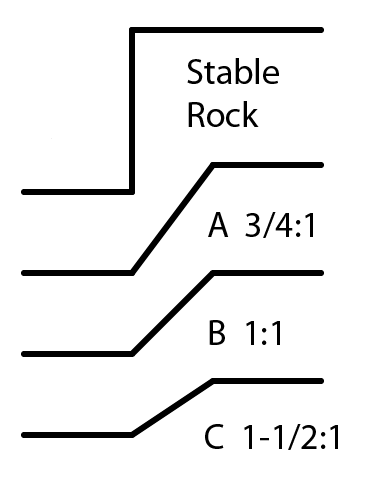Trench Excavation Slope
 Banks and excavations greater than 4 feet MUST be sloped or otherwise retained. If you have the room to slope the amount of slope must not exceed the maximum allowed.
Banks and excavations greater than 4 feet MUST be sloped or otherwise retained. If you have the room to slope the amount of slope must not exceed the maximum allowed.
To determine the maximum allowable slope for an excavation you need to know the soil type in the area. Remember that ALL of these sloped excavations have a maximum depth of 20 FEET, any deeper than that and you must use some form of shoring or layering.
| Soil Type | Max Allowable Slope (H:V) |
| Rock | Veritcal |
| Type A | 3/4 : 1 |
| Type B | 1 : 1 |
| Type C | 1 1/2 : 1 |
accordng to OSHA the slope can never exceed 1 : 2.
Rock
Solid mineral material that remains upright, stable, and intact when it is excavated.
Type A (compressive strength $$1.5 \dfrac{tons}{ft^2}$$ or greater)
These are cohesive soils that contain a good amount of clay. A soil cannot be Type A if:
1. it has cracks
2. there is vibration from traffic or some other source nearby (factory)
3. It has been disturbed recently (geologically recently, like a hundred years)
4. soil is part of a sloped + layered system
If a Type A soil has any of the listed defects it is downgraded.
Type B (compressive strength $$0.5 to 1.5 \dfrac{tons}{ft^2}$$)
1. These are soils that have cohesion (clay)
2. some granular cohesionless soils are, gravel, silt, rocks etc)
3. previously disturbed soils (geologically recent)
4. Type A soil that has cracks
5. unstable dry rock
Type C (compressive strength less than $$0.5 \dfrac{tons}{ft^2}$$)
1. cohesive soil with compressive strength
1. granular soils
2. submerged soil
4. submerged unstable rock
If the site you are working with cannot meet these conditions for a sloped excavation due to available space or some other obstruction, you need to look into using some kind of retaining structure to hold the soil back in the limited space.
Posted in Construction Breadth and tagged construction breadth, excavations, osha, pe exam, trench excavation. Bookmark the permalink. Leave a Comment.


Leave a Comment
Comments (0)